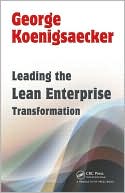Design for Six Sigma: A Roadmap for Product Development
The Latest Tools and Guidance Needed to\ \ Implement Design for Six Sigma in New Product\ \ and Service Development!\ \ \ \ Hailed as a classic in its first edition, Design for Six Sigma has been fully revised and updated to equip you with everything you need to implement Design for Six Sigma (DFSS) in new product and service development.\ \ \ The Second Edition of this indispensable design tool retains the core of the previous edition, while adding new information on innovation, lean...
Search in google:
THIS WAY TO ROBUST DESIGN AND PRODUCTS! FOLLOW THE DOTTED LINE TO SIX SIGMA QUALITY The attraction of Six Sigma is obvious — designs that work, fewer defects in manufacturing, lowered production costs, and greater customer satisfaction. With these pluses, it's no wonder the world's leading companies are adopting the Six Sigma approach to product development in ever-growing numbers. Now here's a powerful engineering resource that makes it easier to implement Six Sigma in new product and service development, one step at a time. Written by hands-on Six Sigma quality experts — who write with the excellence Six Sigma can help you achieve in your products and services — Design for Six Sigma provides unrivalled real-world new product development experience and priceless walkthroughs that help you choose the right design tools at every stage of product development. You get the detailed directions, careful comparisons, and worked-out calculations that make every step easier and make sense of every step. This trailblazing guide is the only resource that gives product and service designers, project and quality engineers, and Six Sigma trainers a true roadmap to product excellence, from customer requirements to customer satisfaction. Writing in a clear, easy-to-follow style, the authors provide: * A systematic method for achieving world-class quality in product development and manufacturing * Revealing inside-industry case studies * Groundbreaking comparisons of traditional quality tools with newer approaches * Focused examinations of engineering tools such as DOE (Design of Experiment), Taguchi Method, Axiomatic Design, and TRIZ (Theory for Inventive Problem-Solving) * All the information, insights, and knowledge covered by the ASQ Black Belt examination Starting with basic Introduction to Quality concepts, Design for Six Sigma goes on to deliver in-depth coverage of essential topics such as: * Fundamentals of Six Sigma * Basic Six Sigma Statistical Tools * Fundamentals of Experimental Data * Taguchi's Robust Parameter Design * Tolerance Design * Introduction to Principles of Design * And much more You'll also find a list of acronyms and a bibliography. Worth its weight in gold to any professional interested in the development of robust products, Design for Six Sigma is a tool you'll turn to again and again — and your quality and productivity is sure to reflect it.
Ch. 1 Quality Concepts 1Ch. 2 Six Sigma and Lean Fundamentals 21Ch. 3 Product Development Process and Design for Six Sigma 57Ch. 4 Design for Six Sigma Deployment 107Ch. 5 Design for Six Sigma Project Algorithm 129Ch. 6 DFSS Transfer Function and Scorecards 185Ch. 7 Quality Function Deployment (QFD) 213Ch. 8 Axiomatic Design 237Ch. 9 Theory of Inventive Problem Solving (TRIZ) 281Ch. 10 Design for X 353Ch. 11 Failure Mode-Effect Analysis 387Ch. 12 Fundamentals of Experimental Design 413Ch. 13 Taguchi's Orthogonal Array Experiment 469Ch. 14 Design Optimization: Taguchi's Robust Parameter Design 499Ch. 15 Design Optimization: Advanced Taguchi Robust Parameter Design 533Ch. 16 Tolerance Design 571Ch. 17 Response Surface Methodology 611Ch. 18 Design Validation 665Acronyms 705References 709Index 717
\ From Barnes & NobleThe Barnes & Noble Review\ Designing quality into products and services is a noble goal. Designing quality for the entire business enterprise is the best way to achieve that goal and to do it faster at a lower cost. Design for Six Sigma will show you how to accomplish both by introducing you to the DFSS methodology. This book includes new and useful methods for bringing quality into every level of doing business on a consistent basis. Authors Kai Yang and Basem S. El-Haik take take their readers through the methodology step-by-step, providing both theory and an implementation process. \ For example, Chapter 1 provides a great background in quality concepts for the business model. Chapter 2 discusses "What Is Six Sigma?" and defines the differences between regular Six Sigma and DFSS. Next, Chapter 3 provides a high-level description of DFSS, its stages and major tasks, and indicates where and how to use DFSS in a company. Chapter 4 discusses the people aspects of DFSS -- how to organize DFSS teams; the roles of master black belt, black belt, and green belt -- and the deployment of DFSS initiatives in a company, along with highlights of financial aspects of DFSS projects. Next, Chapter 5 is a very detailed description of the DFSS project implementation process. Chapters 6 to 18 are the DFSS methodology chapters. Finally, the addition of a acronym list is outstanding, but an actual glossary at the end of each chapter or as an appendix would have made this book the ultimate road map for product development.\ So, how could anyone responsible to management or customers for the quality of a company's products and services not want this excellent book in their arsenal? DFSS is a fascinating subject, and Design for Six Sigma is destined to drastically sharpen your skills in the art and science of improvement. John Vacca\ John Vacca, the former computer security official (CSO) for NASA's space station program (Freedom), has written 38 books about advanced storage, computer security, and aerospace technology.\ \ \








